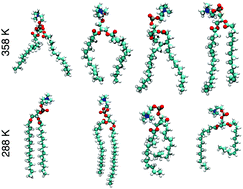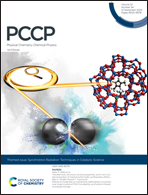A machine learning study of the two states model for lipid bilayer phase transitions†
Abstract
We have adapted a set of classification algorithms, also known as machine learning, to the identification of fluid and gel domains close to the main transition of dipalmitoyl-phosphatidylcholine (DPPC) bilayers. Using atomistic molecular dynamics conformations in the low and high temperature phases as learning sets, the algorithm was trained to categorise individual lipid configurations as fluid or gel, in relation with the usual two-states phenomenological description of the lipid melting transition. We demonstrate that our machine can learn and sort lipids according to their most likely state without prior assumption regarding the nature of the order parameter of the transition. Results from our machine learning study provide strong support in favour of a two-states model approach of membrane fluidity.

- This article is part of the themed collection: Emerging AI Approaches in Physical Chemistry


 Please wait while we load your content...
Please wait while we load your content...